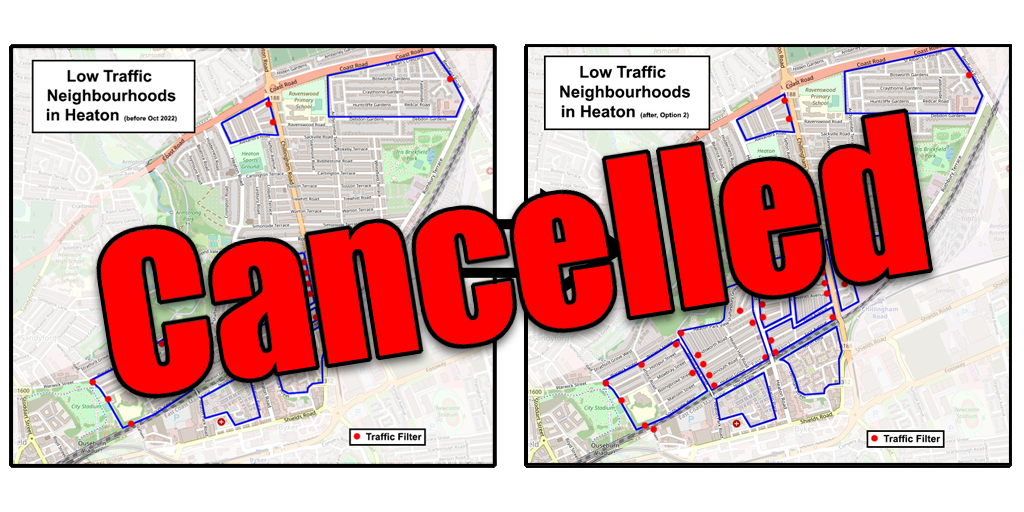In February 2024, in an article titled “Council Plan sets pathway for Newcastle’s future”, the City Council set out it priorities for 2024-2027.
Labour Councillor Nick Kemp, Leader of the Council, talked about how the plan directs what the Council will do and how it will work alongside the residents of the city.
The announcement went on to highlight the principles upon which the Council will deliver services which were
- Resident Focused
- Sustainable and well governed
- Evidence and data driven
- Equitable, diverse and inclusive
Over the past few years the Council has spent a lot of time consulting on and eventually implementing trial schemes aimed at making streets safer and better places to live in three areas of the city – Fenham, Jesmond and Heaton.
In a city where 38% of households don’t have access to a car the schemes were a small step towards making the transport infrastructure of the city more equitable.
The schemes created quieter streets which became a more appealing option for people wishing to travel sustainably, a more viable option for people who need to walk, wheel or cycle, and created the opportunity for the 18% of Newcastle’s population that are too young to drive to travel more independently.
All this was done while keeping access by vehicles open to all properties.
In Heaton the scheme focussed on an area that had been left out when other parts of Heaton had been altered around 40 years ago.

However, starting with Fenham before moving on to Jesmond and finally Heaton, the Council has now methodically removed or announced the removal of all three schemes.
By May 2024 there will be nothing left of any of the three schemes beyond a promise to listen to residents about doing something else in the future, despite all three schemes having been consulted on extensively already.
A report on the Jesmond scheme stated “When considering the initial aims and objectives of the project identified in paragraph 3.7, it is evident from the monitoring data above that on the whole these have been achieved.”
Paragraph 3.7 of the report set out the objectives the scheme was designed to meet.
Elsewhere, the Jesmond report detailed how data collected on air pollution, accidents and emergency response times was in contradiction to many of the complaints made about the scheme.
Despite meeting the initial objectives, which were backed up by evidence and data, the scheme was removed. One of the reasons given for the removal was the extra time it was taking for people on one street to drive between the front and back of their houses.
At the time of writing there isn’t a report on the Heaton scheme available, but in an article on its website the Council appears to be focusing on the fact some traffic was diverting down back lanes which remained unfiltered rather than sticking to main roads.
The problem in the back lanes was an inevitable consequence of creating a scheme that wasn’t fully impermeable. A very similar problem happened in Jesmond and was solved quickly by making the scheme fully impermeable.
There was no mention of data from permanent traffic counters that shows that around 500 fewer vehicles per day were travelling through the area. The counter showed traffic was lower almost every week the trail was in place, compared to the previous year.

As recently as March the Council consulted on additional options for Heaton, one of which would have fully solved the problem in back lanes. The other option included moving some filters, removing others and adding in a pedestrian crossing. The option of removing the scheme completely wasn’t put forward.

Instead of addressing and fixing the issues raised, on a day which saw the Coast Road at a standstill and roads across the city creaking under the pressure of flooding the Council chose to announce the full removal of another scheme that could have made the city’s transport network safer and more resilient.
As in Fenham and Jesmond, the only thing left is a promise that the “conversation will continue” and more consultation will happen.
If what has happened in Fenham, Jesmond and now Heaton is a reflection on how the Council will carry out its plan in the years remaining up to 2027 it appears the principles that are supposed to lead it may be a little misleading.
Meanwhile, the residents of Heaton can once again share the experience of thousands of vehicles being driven down narrow streets with people in Fenham and Jesmond.

